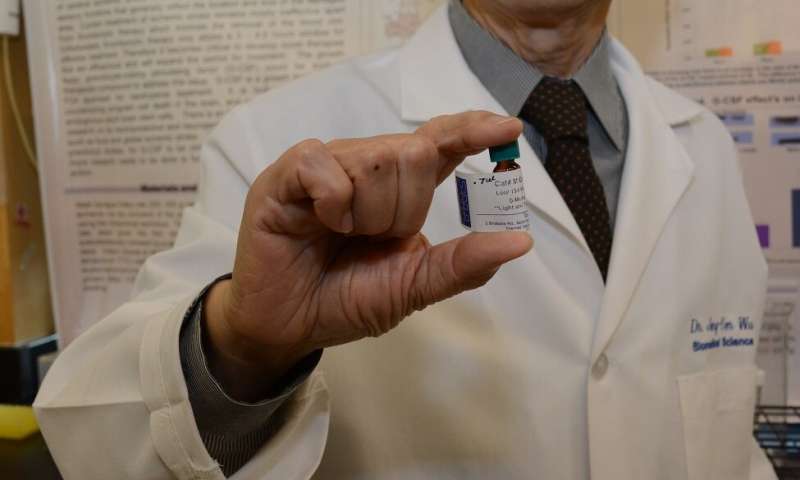Source: Thailand Medical News Jan 30, 2020 5 years, 2 months, 3 weeks, 6 days, 16 hours, 49 minutes ago
Currently,
stroke is the third leading cause of death and disability globally. More than 87 percent are
ischemic strokes, caused by obstruction of one or more cerebral arteries. With limited progress in developing treatments, there is a critical need for neuroprotective agents to effectively treat
stroke.
 A bottle containing granulocyte colony-stimulating factor (GCSF), currently used to treat
A bottle containing granulocyte colony-stimulating factor (GCSF), currently used to treat
neutropenia due to chemotherapy and used is for patients who require bone marrow
transplants now being used to treat stroke. Credit: Florida Atlantic University
A new study from Florida Atlantic University's Schmidt College of Medicine holds promise for a new way to treat
stroke using an already FDA-approved drug ie
granulocyte colony-stimulating factor (
GCSF).
GCSF enhances blood cellular development and is currently used to treat neutropenia (low white blood cells) caused by chemotherapy and has successfully been used with very few side effects for patients who require bone marrow transplants to stimulate blood cell formation.
The research study, published in the Journal of Biomedical Science, is the first to report on the neuroprotective effect of
GCSF against autophagy and mitochondrial stress in vivo. The data support the hypothesis that
GCSF is one of the few growth factors that can reduce infarction by decreasing endoplasmic reticulum (ER) and mitochondrial stress while improving behavioral performance.
Study results showed that
GCSF improved neurological deficits that occur in the first few days following
cerebral ischemia and improved long-term behavioral outcomes while also stimulating a neural progenitor recovery response. Researchers tested behavioral performance on corner and locomotor tests, used as an indicator of brain injury.
Utilizing a mouse model, researchers investigated the efficacy of
GCSF beyond the typical four-hour thrombolytic therapy (tPA) clot-busting drug, the gold standard to treat
stroke for global
ischemia. They examined the pro-survival mechanisms of
GCSF against apoptosis resulting from autophagy, mitochondrial stress and ER stress.
Dr Jang-Yen (John) Wu, Ph.D., corresponding author, distinguished Professor of Biomedical Science in FAU's Schmidt College of Medicine, and a member of the FAU Brain Institute (I-BRAIN) told
Thailand Medical News, "In recent years, many studies including ours have shown that as an endogenous growth factor and immune system modulator factor,
GCSF is beneficial in models of neurological disorders such as
stroke and traumatic brain injury. Although the anti-apoptotic activity of
GCSF is reported in global
cereb
ral ischemia, this mechanism has not been fully explored."
Medical researchers used a mechanism-based therapeutic approach for
stroke first to examine the connection of mitochondrial, autophagy and ER stress inhibition in the protective action of
GCSF and then to analyze relevant ER stress pathways in the bilateral common carotid artery occlusion (BCAO) model of stroke. They confirmed the neuroprotection of
GCSF gene therapy in the BCAO mouse stroke model by a decrease of dynamin-related protein (DRP1), a marker of mitochondrial stress, in the frontal and middle brain of the
GCSF treated group.
The new protocol involved the initial dose of
GCSF being administered 24 hours post-BCAO and then followed by a single application of the same dose for another three days for a total of four days of administration. Researchers examined behavior and used immunoblotting to analyze key proteins in ER stress, autophagy and mitochondrial stress-induced apoptosis. BCAO mice receiving
GCSF protein showed significantly less asymmetric turning in the corner test than BCAO mice without
GCSF. In the behavioral assays,
GCSF elicited increased locomotor sensitization verified by greater activity in the locomotor activity test, demonstrating the neuroprotective properties of the drug.
Dr Howard Prentice, Ph.D., corresponding author, a professor of biomedical sciences in FAU's Schmidt College of Medicine, and a member of FAU's I-BRAIN added, "More than 15 million people worldwide suffer from
stroke and our study provides new and important insights into
GCSF induced protection as it relates to ER stress and mitochondrial stress activated apoptosis. Future research will need to focus on uncovering the complete mechanisms by which
GCSF retains the ER and mitochondrial homeostasis."
Dr Wu and Dr Prentice have been developing
GCSF as a therapeutic method to replenish new brain cells because of its ability to preserve the central nervous system, suppress cell death and at the same time elicit neurogenesis as well as angiogenesis.
GCSF works the same way for other neurological diseases such as Parkinson's disease due to its neuroprotective properties.
Reference : Mode of action of granulocyte-colony stimulating factor (G-CSF) as a novel therapy for stroke in a mouse model, jbiomedsci.biomedcentral.com/a … 86/s12929-019-0597-7
